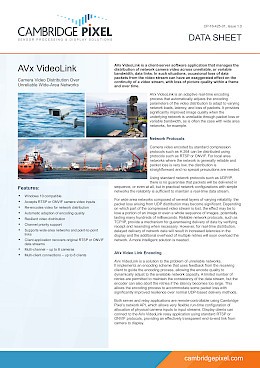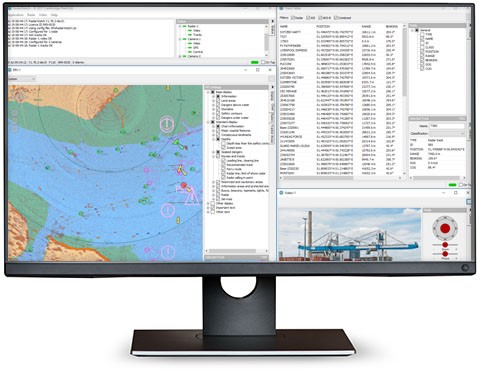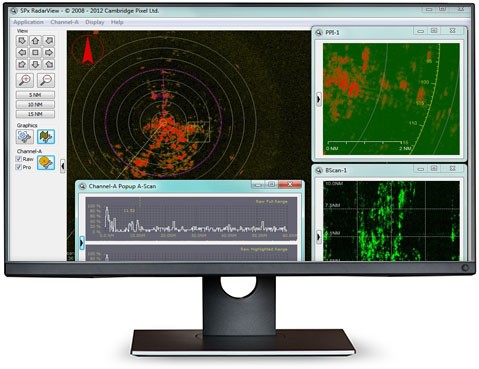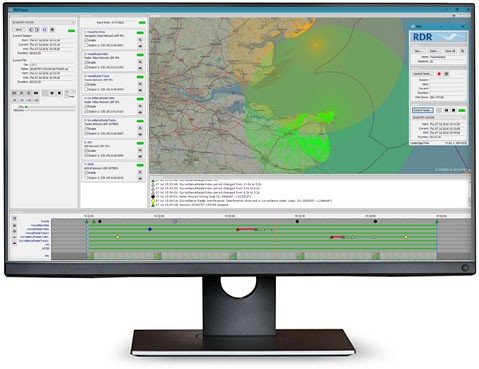AVx VideoLink comprises two distinct parts:
- a server process to manage receipt of camera video and onward network distribution
- a relay process to monitor network performance and provide the client interface
The server and relay processes reside at either end of the unreliable link. Display clients can connect to the AVx VideoLink relay application using standard RTSP or ONVIF protocols, providing an effectively transparent end-to-end link from camera to display.
AVx VideoLink can be used in conjunction with other Cambridge Pixel products. For example, the RadarWatch application provides a field-proven and operator-friendly combined display of radar and multiple camera video streams. The RDR data recording and replay application can record radar video and camera video together with other data streams. RDR can be deployed near the sensors, co-located with the AVx VideoLink server, to record ‘original quality’ camera video that can then be replayed, at the same time as live video, across a WAN or point-to-point link for display
Network Protocols
Camera video encoded by standard compression methods such as H.264 can be distributed using protocols such as RTSP or ONVIF. For reliable local area networks, this approach works well and no special precautions are required. Using standard, connectionless network protocols such as UDP/IP, there is no guarantee that packets will be delivered in sequence, or even at all, but in practical network configurations with simple network topologies the reliability is sufficient to maintain a real-time data stream.
In wide area networks, for example those relying on low bandwidth data links, the packet loss arising from UDP distribution may become significant. Depending on which part of the compressed video stream is lost, the effect may be to lose a portion of an image or even a whole sequence of images, potentially lasting many hundreds of milliseconds. A connection-oriented protocol, such as TCP/IP, provides a mechanism for guaranteeing delivery of data by verifying receipt and resending when necessary. However, for real-time distribution, delayed delivery of network data will result in increased latencies in the display and the additional overhead of multiple retries will soon overload the network.
AVx VideoLink Encoding
The special AVx VideoLink encoding provides the perfect balance between low overhead/latency and high reliability. Feedback from the receiving client allows the encode quality to dynamically adjust to the available network capacity. A limited number of retries are permitted to maintain the consistency of the data stream, but the encoder can also abort the retries if the latency becomes too large. This allows the encoding process to accommodate some packet loss with significantly improved resilience over normal UDP-based delivery methods.
A maximum per-channel bitrate can be specified, allowing only a portion of the available link bandwidth to be used so that other applications can share the link. If latency or packet loss worsen at any given time, the bitrate is automatically reduced from the configured maximum.
AVx VideoLink can use a combination of hardware-based and software-based H.264 encoding in the server application, allowing optimum use of the resources available. As well as encoding camera video at an adaptive rate to meet the preconfigured or real-time bitrate requirements, the server application can optionally modify the frame rate to meet the constraints of the link bandwidth.
- Windows compatible
- Accepts RTSP or ONVIF camera video inputs
- Re-encodes video for network distribution
- Automatic adaption of encoding quality
- Resilient video distribution
- Channel priority support
- Supports wide-area networks and point-to-point links
- Client application recovers original RTSP or ONVIF data streams
- Multi-channel, multi-client:
- up to 8 cameras
- up to 8 clients









